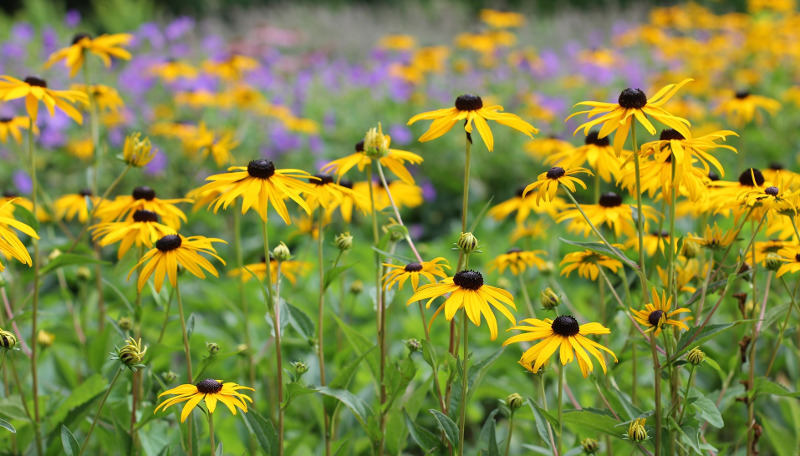Many gardeners wonder if they should fertilize their coneflowers even though they are native, hardy perennials that thrive with little care. The key is to fertilize or top-dress them just enough to keep them thriving and lush, but not so much that they get leggy or spindly. Get more information about how, when and with what to fertilize coneflowers.

How do you know if your coneflower plant needs to be fertilized? Keep an eye on its new growth, particularly in the spring. A healthy plant will exhibit steady growth until the root mass is about 2’ wide and the plant is up to 3’ tall, depending on the species. If your plant seems to be struggling to put out new growth, applying a store-bought fertilizer in the spring is a good choice.
However, if your plant is healthy, you can help it thrive by simply applying compost. The organic material, beneficial microbes and nutrients will keep it healthy and happy.
As for fertilizing a newly planted coneflower, it’s always a good idea to add some fertilizer to the ground the day you plant to encourage strong root establishment and get a healthy start for growth and flowering.
How to Fertilize Coneflowers
How and with what you fertilize your coneflowers will depend on your local soil. If you’re not sure what kind of soil you have, ask your local extension office about getting a soil test or about your local soil types. There’s a large variety of coneflower species, and the ideal soil pH can vary between them. The beloved purple coneflower (Echinacea), for example, enjoys a relatively neutral pH between 6 and 7.
If your soil is highly acidic or alkaline, and you want to grow purple coneflowers, you will need to amend it to bring it closer to neutral. However, coneflowers are not fussy plants and are known to thrive in a variety of soils, including rocky, clay and sandy loam soil.

Focus on feeding your coneflowers the nutrients and the organic matter that will lead to long-term health. If you’re applying a layer of compost or well-rotted manure annually, it’s unlikely you’ll need additional fertilizer. The plants love a top dressing of compost to encourage healthy soil and therefore a healthy plant.
To “top dress”, pull away the mulch around your plant and add a 1-2” layer of compost. You can take your hand and “rough,” or mix it into the top layer of soil. Spread the mulch back over the layer and around the plant. Then, water it in. Be sure you’re not overwatering – coneflowers hate soggy soils!
It’s also important that you don’t over-fertilize your plants. Not only will the extra fertilizer make them leggy and floppy, it can also damage your soil. Lawns and gardens alike are prone to the unsightly “fertilizer burn” that happens when someone has gotten overzealous with their chemical fertilizer treatment.
The best way to grow healthy plants is to be a steward of your healthy soil; and all that entails is keeping your garden covered in mulch, top dressed with compost, and minimally fertilized or treated. A little goes a long way!
Best Time To Fertilize Coneflowers
The best time to fertilize coneflowers is in the early spring, just as new growth is starting to arrive. The plants love the extra boost of nutrients as they are in a fast growth cycle. Coneflowers only need to be fertilized once a year. If you forget in the spring, it’s okay to fertilize in the fall. The nutrients will be there for root growth in the winter and green growth in the spring!

Best Fertilizer for Coneflowers
The best possible fertilizer for coneflowers is simple, and can be made by you in your own back yard — compost! If you don’t have your own compost, you can easily find a bag at your local nursery or get a load from a landscape supply company. Well-rotted manure does the trick, as well, and can also easily be found for decent prices.
However, you may need an extra boost of nutrients when planting or caring for your coneflowers, so here are some recommendations. Choose a balanced, organic or natural fertilizer with active microbes. Our favorite is OMRI-listed Happy Frog All Purpose fertilizer, which is 6-4-5 NPK mix. I don’t recommend using any kind of synthetic fertilizer like Miracle Grow, especially on native perennials like coneflowers. It’s not necessary and can end up damaging the healthy balance of your soil and its intricate ecosystem.
There are many benefits to growing plants that are native or well-suited to your area and soil, and not having to spend money or time on fertilizer is one of them!
Coneflower Fertilizing Tips
- Fertilize or top-dress in the early spring, when new growth begins to appear.
- Water immediately after applying the fertilizer/topdressing, but be sure not to over water.
- Fertilize with topdressing of compost or well-rotted manure.
- If your coneflower plant is struggling to add new growth in the spring, use a balanced fertilizer like Happy Frog All Purpose 6-4-5.
- Do not over fertilize. You may avoid store-bought fertilizer altogether if you are applying compost annually.
Warnings
-Always wear protective gloves and a face mask when handling chemical fertilizers.
-Closely follow all directions and storage guidelines that are on the fertilizer label.
 |
Emily Reeves - Published 11-13-2020 |
